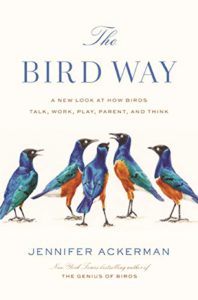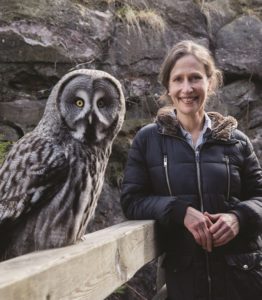Long ago, my children and I celebrated at the library whenever we came across a favorite picture book by Arnold Lobel. No matter how many times we read it, The Ice-cream Cone Coot and Other Rare Birds reliably induced giggle fits. We loved the ridiculous names, cantering rhymes, and cleverly bizarre illustrations. “I do not trust the Jackknife Niffy./ He could swoop down and cut off your nose in a jiffy.” Lobel’s illustration of a stunned child watching a winged pocket knife with tiny feet swoop across the page expanded our delight.
I found myself experiencing similarly gleeful moments while reading Jennifer Ackerman’s The Bird Way: A New Look at How Birds Talk, Work, Play, Parent, and Think. Odd names and extraordinary behaviors surprised me throughout, frequently causing me to laugh aloud. Social, playful, curious keas, found only in alpine areas of New Zealand, unscrew car antennae and destroy satellite dishes, untie shoelaces and collaborate to solve hard puzzles for food rewards. Brilliant, mistrustful ravens, who hate anything new, take one another down, just for fun, by yanking each other’s legs. These same ravens actually “sled” down hills covered in fresh snowfall and enjoy snowball fights with humans. “It looks absolutely crazy,” a researcher remarked to Ackerman.

In The Bird Way, Ackerman’s follow-up to The Genius of Birds, she focuses on what, at first glance, does seem crazy — examples in bird life that fall on the extreme ends of a variety of spectrums. With these choices, Ackerman explains that she hopes to “push the edges of, well, birdness.” The mind-bendingly wide range of feathers, abilities, and behaviors forces researchers to reconsider what they think they know about birds. The examples also force readers to reexamine what we think we know about people. Humans aren’t the only species, for example, to start fires, pass down cultural practices, mimic, or collaboratively solve problems. Researchers are increasingly reevaluating what scientists have considered evidence, at times appreciating more fully indigenous peoples’ reports and creation stories. Central to Ackerman’s mission is to demonstrate that those considered to be human “outliers” — in same-sex relationships, for instance, or co-parenting beyond the bounds of nuclear family units — have cross-species validations around the globe. “Clearly,” Ackerman writes, “there is no one way to be a bird, just as there is no one way to be a human.”
As for the humans Ackerman describes in the book, their behaviors and strategies are, at times, as inventive and funny as the birds they study. To figure out how geese fly at heights greater than 16,000 feet in the Himalayas, researchers in Austin, Texas, fitted the birds with tiny backpacks and masks and trained them to fly through a wind tunnel. Wanting to understand how birds perceive color, scientists deployed a spectrophotometer to measure ultraviolent light reflected from a forest, then ran the data through a computer to align it with bird perception. Perhaps not surprisingly, as more women have conducted studies to earn Ph.D.s, they have challenged fundamental assumptions about birds, most of which men generalized from observations of males, just half of any given population.
Because Ackerman has an excellent sense of humor, she keeps readers engaged even when explaining dry or technical information. Sometimes, she throws in good stories or exchanges simply because they intrigue. A researcher observes that ravens seem to have an affinity for old university towns — Lund, Oxford, Cambridge, Uppsala — and he theorizes that ravens are themselves academic. “ ‘But difficult to work with,’ I say. ‘Yes,’ he says, ‘true of many academics.’ ”
Ackerman is as comfortable tossing off references to Jar Jar Binks as she is to English literature or Latin etymology. She is “learned” in the best possible way. She shares her excitement about what her capacious mind is capable of learning about extraordinary creatures. She explains that these creatures also often have capacious minds and are capable of remarkable learning.

Ackerman is a wonderful writer, but words alone aren’t always sufficient to help readers fully imagine her subjects. She writes poetically about her trip through an Australian eucalyptus forest in search of the elusive lyrebird: “The lyrebird sings like no other bird, a fantastic blend of its own calls and songs of dozens of perfectly mimicked sounds, brilliant imitations of other bird voices in the forest, from the explosive ‘whipcrack’ of the eastern whipbird to the ringing pee-o of the grey shrike thrush, from the stuttered creaks of gang-gang cockatoos to the silvery sweet chant of the pilotbird.”
As is true at each chapter’s beginning, she includes a lovely black-and-white line drawing of the lyrebird. These static images do not move or sing, fight or play. Short of photographs, how much better would have been Arnold Lobel’s color illustrations. (Think: coot with sugar cone beak and body.) It’s a testament to Ackerman’s gifts as a thinker, writer, and teacher that I found myself typing “lyrebird mimic song” into the search function of YouTube.



